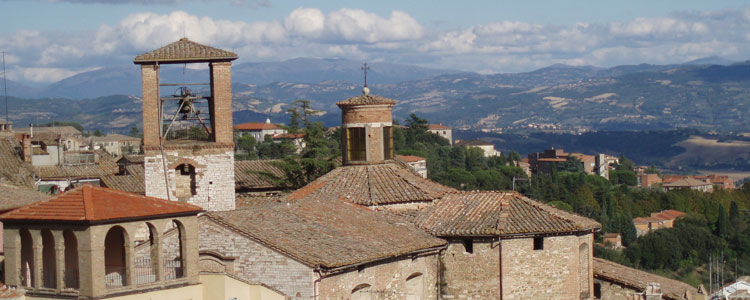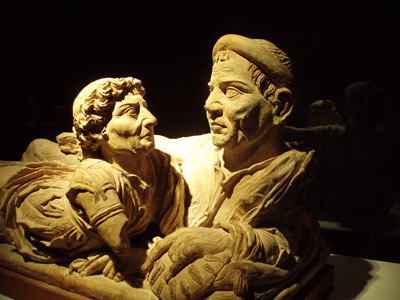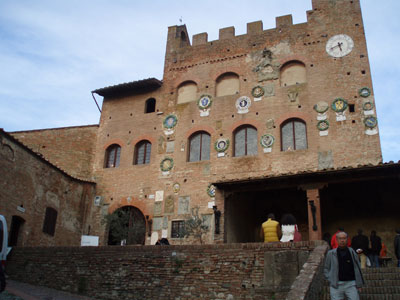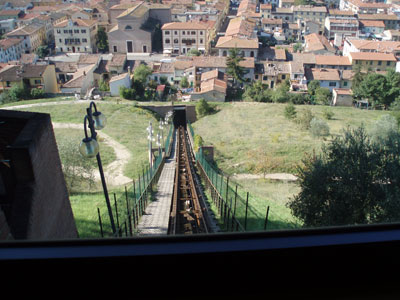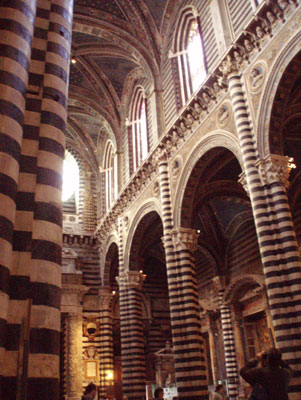Visiting the hilltop towns of Tuscany and Umbria
by Marilyn Lutzker, Sunnyside, NY
There are advantages and disadvantages to being older. Neither my friend (at age 81) nor I (77) wanted the responsibility of driving in Italy, but I am old enough to have a son with adult children, himself, who was willing to devote a week to driving his elders around.
Peter joined my friend and me with a rented car after we had spent six days in Florence. Preferring taking day trips from a central base to moving every night, we had arranged for three nights in a hotel in Perugia followed by four nights in an apartment in Certaldo Alto before returning to Florence to return the car.
Perugia
Perugia is a small, medieval hilltop city grown into a modern metropolis. The capital of the province of Umbria, it deserves a higher place on the tourist agenda than it currently seems to occupy.
Stone streets, stone walls, stone archways and stone steps worn down by the centuries define the city, as they do the other medieval cities and towns of Tuscany and Umbria. In Perugia, I was a bit intimidated by the ups and downs, by the narrowness of the so-called streets and by the audacity of the drivers, but by the time we had visited several other medieval cities and towns, I was able to appreciate the agelessness of these ancient pathways and revel in the experience, even if I was still unnerved by the nerve of some of the drivers.
One-way streets, pedestrian-only streets and streets with no street signs overlay a basic grid designed by meandering medieval cows, making Perugia one difficult place for driving! Arm yourself with a detailed street map, a readiness to ask questions at every crossroads, the expectation of seeing the same corner several times and a sense of humor. It took us two hours to find our hotel.
And then there were the views. The reward for all those corkscrew turns, ancient alleys going up at 45-degree angles and staircases appearing when you expect the way ahead to be straight was the views. They were everywhere, including from Hotel Priori, where we stayed. Some of the most spectacular could be seen from the market behind the Piazza Giacomo Matteotti.
Art in Umbria
The National Gallery of Umbria, located in a recently renovated medieval palace, was heaven for this lover of medieval and Renaissance painting. Although the number of works there by the more famous painters probably doesn’t rival the number in Florence’s Uffizi, the dozens of works with the tantalizing labels of “Master of …” or “School of …” were, to my eyes, true masterpieces.
And, in mid-October, my eyes were most often the only ones looking at them. This museum was an antidote to the crowds in the more famous Uffizi.
If the naiveté and religiosity of early Renaissance painting has never appealed to you, give it a try in this gallery. The opportunity for silent contemplation of these works, in spacious well-lit galleries, may win you over.
Assisi day trip
A revered attraction for centuries, the 13th-century frescoes in Assisi’s Basilica of San Francesco provided a viewing experience which made me say, “Now I understand what all those books were talking about.”
Although my mind’s eye had made this visit many times, I was unprepared to be enveloped by the gloomy solemnity of the basilica’s Lower Church. As my eyes adjusted to the darkness, jewel-like colors began to emerge. Scenes from the life of Saint Francis covered the walls and climbed the vaults and ceilings, decorative all-over patterns embellishing every space in between.
The Upper Church, the site of the famous murals believed to have been painted by Giotto di Bondone, was brighter but equally solemn and quiet. The murals were badly damaged by an earthquake in 1997 and there was considerable concern about whether they could ever be returned to their original state, but, thanks to modern technology and funds from the Vatican (which owns the basilica), they have been remarkably restored.
Although visitors filled the basilica, aggressive guards in military uniform, aided by priests and friars leading some groups, rigidly enforced the “Silence! Silencio!” dictum, and the prevailing mood of solemnity was undisturbed. (I whispered to my friend and was “beamed” by a priest’s laser pointer!)
Assisi is a hill town, so just keep driving up the hairpin curves until you get to the top. Although there are several car parks along the way, the most convenient is underneath the piazza near the top (€5 for three hours). From there, there is still an uphill walk to the church.
Traveling through Tuscany
After three nights in Perugia, we spent most of the day driving to Certaldo Alto, our base for the next four nights. Heading quickly for what we had been told were the most scenic areas, we took major roads from Perugia to Asciano, where we stopped for lunch. The afternoon’s drive on Rte. 438 from Asciano toward Siena, then Rte. 222 to Castellina in Chianti (worth a stop) and Rte. 429 west to Poggibonsi was a highlight of my trip.
Think calendar pictures which have surely been retouched and you may be able to picture the Tuscan landscape. This was what I had waited years to see.
Fortunately, the endless curves, bends, ups and downs required our diesel-fueled Fiat Panda to move at a moderate rate, allowing ample time to “Ooh!” and “Ahh!” at every turn in the road.
Certaldo Alto
By now, you must be aware of my fascination with the medieval; thus, the opportunity for me to spend four nights in a small medieval walled town was irresistible.
Only 180 people live year-round in Certaldo Alto, situated high above the rather dull modern city of Certaldo. With ancient brick walls, stone streets, narrow winding alleys, multiple arches and staircases and almost no cars, this tiny place offers the “medieval city experience” without the tourist shops and crowds of the more famous San Gimignano.
Although Certaldo Alto boasts of its museum network — which includes the Palazzo Pretorio, Boccaccio’s House (he was born and died here) and the Museum of Sacred Art — the true attraction is the town, itself. In high season, the town’s piazzas and terraces are reputed to be full of day-trippers, who come to savor the atmosphere and delight in the views of the surrounding Tuscan countryside. In mid-October, we had it all to ourselves.
To reach the Old City, you can walk up the hill from the modern city of Certaldo (which takes about 15-20 minutes) or take the five-minute ride on the funicular (€1.20 round trip), which runs four times an hour. Alternatively, you can arrange an overnight stay, in which case your host will provide a parking sticker and a gizmo to lower the stanchions that block the road to cars and will show you where to hide your car.
A great base
Certaldo Alto is a perfect location from which to take day trips. Volterra, San Gimignano, Siena, Colle di Val d’Elsa, the Chianti area and some of Tuscany’s most awe-inspiring scenery all are within an hour’s drive. Florence is only 50 minutes away by train. And when you return “home,” there are more stone steps, winding lanes and scenic views.
The town has several restaurants, two coffee shops, a wine bar, an ice cream store, a pottery studio and a cooking school. There is no ATM and no grocery store, although snacks, bread, wine, bottled water and soda are available in Bar Boccaccio and La Bottega di Chichibio, both on Via Giovanni Boccaccio, the main street.
Most evenings in Certaldo Alto, we were happy just relaxing in our apartment over a simple dinner of wine, cheese, Parma ham and bread bought during the day. On our last evening, the three of us dined very well for €57 ($82) at the pleasant L’Antica Fonte restaurant.
Breakfast was fresh croissants and cappuccino at Bar Boccaccio. For a special treat, ask for a “special” cappuccino. It’s a work of art.
Visiting Volterra
Volterra, built on one of the highest hills of Tuscany, was the center of the pre-Roman civilization of Etruria. Some consider this Etruscan/Roman/medieval city to be the best-kept secret of the province.
Surrounded by its 13th-century wall, Volterra’s cobbled streets, meandering lanes, stone arches, palaces, churches and museums reflect the town’s history. I was there only for a few hours but could have enjoyed several days.
The Museo Etrusco Guarnacci owns more than 600 stone funerary urns, most featuring a carved figure of the deceased reclining on an elbow as if at a banquet. I’m not sure all 600 were on display, but, staring at row after row after row of them on the ground floor of this decidedly old-fashioned museum, I was tempted to leave, but this collection of Etruscan art is world famous, so I tried to focus.
One floor up, the curators have made it easier. There, individual carvings, vases and bronze statues were displayed in well-lit niches and I began to understand why this somewhat enigmatic pre-Roman culture fascinates historians.
Scenes obviously based on Greek myths had a heroic naturalism, while depictions of everyday life gave a pragmatic picture of the delights of a comfortable life on Earth. The stark simplicity and modernity of some of the sculptures was equally surprising and delightful.
Volterra’s first-century Roman theater was rediscovered in the 1950s after centuries of obscurity. With tiered steps set into the slope of a hill and marble columns supporting the two-storied backdrop, this theater is among the best-preserved Roman ruins in Italy.
We followed the signs from Via Guarnacci to the theater and then, following Rick Steves’ directions, opted for the view from above (on the city wall promenade) rather than entering the theater itself. I think it was a wise choice.
Volterra is known as the alabaster city, and gift shops throughout the city offer ample opportunity to view and purchase a wide variety of alabaster items at prices which I found to be exorbitant. The best prices, by far, were in the Co-op store on Piazza dei Priori, near the Palazzo dei Priori (city hall).
Siena excursion
I have come to expect wonderment at what the 13th century produced. Size alone would make Siena’s Duomo, considered one of the finest examples of Italian Gothic architecture, impressive. From the outside, the endless bands of black and white marble and the ornate sculptural façade are like the icing on a very large cake.
It took a few moments to adjust to the interior. It felt even bigger than it looked from the outside, and the black-and-white striped arches and pillars were dizzying. This is a very large, very busy, very ornate interior, and it was hard to know what to look at first.
There are paintings and frescoes lining the walls, Nicola Pisano’s 13th-century pulpit sits in the nave and, in a separate room, there is the Piccolomini Library with 16th-century frescoes by Pinturicchio and illuminated manuscripts that deserve a museum for themselves.
The floor, with 59 large, etched and inlaid marble panels, was astonishing. I have never seen anything like them before, and I kept returning to wonder at the detail, which illustrates Bible stories and scenes from Siena’s history.
Being totally overwhelmed by the splendor of the Duomo, itself, I was tempted to skip the Duomo Museum but am really glad I didn’t. In one relatively small room, I had the unique opportunity to truly stand eye to eye with the prophets and patriarchs whom Giovanni Pisano originally sculpted for the façade of the cathedral. (They were replaced by replicas in the 19th century.)
Seventeen feet high, 34 feet wide and painted on both sides, Duccio’s “Maestà” (“Enthroned Virgin”) was conceived to educate and overwhelm the 14th-century worshipers who faced it in the cathedral. Today, on the second floor of the museum, the Madonna and child depicted still sit on a richly decorated marble throne with angels and saints crowding around. Each panel of this Renaissance masterpiece vibrates with color and emotion, demanding as much reverence today as it did in 1311, when it was finished.
After all that art, I really needed a cappuccino, so we headed for the Campo, Siena’s famous town square. The area around the Duomo is flat, but Siena is a hill town and the Campo was decidedly downhill from where I stood. The very steep stone staircases leading down were a bit intimidating to me and my cane, so I found a broad ramp — which turned out to be equally steep. Once down, I lifted my eyes to one of the best squares in Italy.
More elliptical than square, there was a harmony to the buildings and an excitement in the air. The cafés and restaurants lining two sides were perfect for people-watching and the contemplation of architecture.
If you are traveling to Siena by car, it’s probably wise to arrive early, as parking can be difficult.
Hill towns like Certaldo, Volterra and Siena are, by definition, high up, and in mid-October it didn’t take flags waving so vigorously that they looked about to tear apart to make me realize this. I felt it, especially in Siena, and was glad for the extra layers, the scarf and the woolen hat I was wearing.
Where to stay
Certaldo Alto — Our host in Certaldo Alto was Elio Ansaldo, who rents several apartments under the umbrella name Borgo Toscano. Our two-bedroom, two-bath apartment, the Pisa (Via delle Mura 3; phone 39 057 1663029, cell 39 339 7679738), felt luxurious, especially after staying in two-star hotel rooms. It had a fully equipped kitchen, nice furniture and artwork, sufficient storage space and comfortable beds.
Elio was a gracious host, providing maps, brochures and multiple sightseeing hints for the area. We were there for four nights, but the apartment was comfortable enough, and the surrounding area interesting enough, for a longer visit.
If you opt to stay there, Elio will e-mail directions to meet him in the lower town, from where he will lead you to the apartment. In addition to a sign for your car permitting you into the car-free upper town, you will need an electronic gizmo to lower the poles which block entry to all but residents and guests.
Our apartment cost €65 ($94) per night plus a €50 final cleaning fee and €10 per night for central heating, if requested.
Florence — The two-star Hotel Maxim (Via dei Calzaiuoli 11; phone 39 055 217474) is situated on the third floor of a building located just between the Uffizi and the Duomo. A better location doesn’t exist.
The basically furnished rooms, with stall showers (some with doors, others just curtained off), were clean and well cared for. In addition to a helpful staff, the hotel had a comfortable living room for guests and two computers with free Internet access. Espresso, bottled water, beer and soft drinks were for sale at the reception desk.
Breakfast offered an all-you-can-eat buffet of fresh croissants and rolls with the usual accoutrements plus yogurt, drinks and canned fruit salad.
Rooms cost €84 ($121) per night, double, and €55 per night, single.
Perugia — The two-star Hotel Priori (Via dei Priori; phone 39 075 5723378, website in Italian only) is perfectly located for visiting the city. The sparsely furnished rooms were clean, and there were several comfortable public lounges, both indoors and outdoors.
Though the glass-walled breakfast room had marvelous views of the city and countryside, the breakfast itself was disappointing. The convenience of the location and the helpful staff, however, more than made up for the deficiencies of breakfast.
Rooms cost €65 per night, double, and €45 per night, single.
Useful guidebooks
I have always used the Frommer guidebooks for my initial trip planning. The spacious layout and easy-to-read typeface add to their value as information sources. Once on site, I find Rick Steves’ detailed directions and guides to individual museums and sights most useful.
In planning routes for this trip, I found the Thomas Cook “Drive Around Tuscany & Umbria” guide a useful addition to the information in Frommer.

